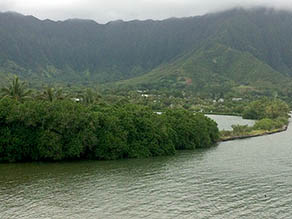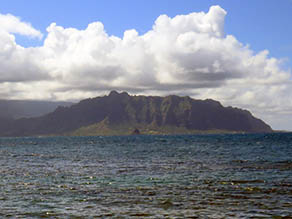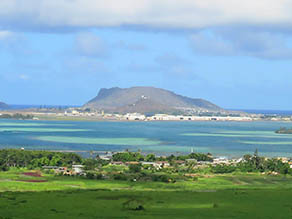 |
 |
 |
 |
||||||
|
|
|
|
|
|
|
|
|
|
 |
|
 |
 |
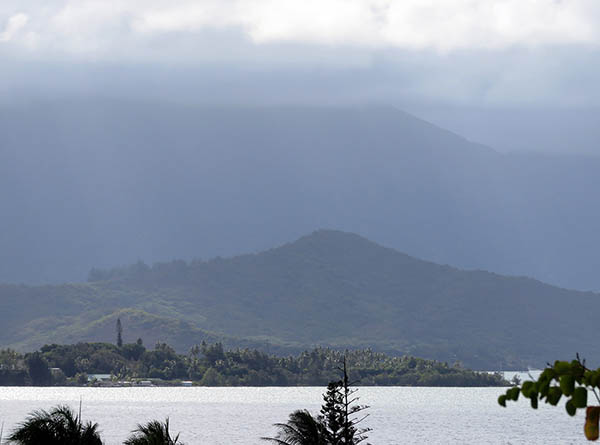
The hill Mā‘eli‘eli.
Westervelt, in his recounting of the legends of Maui, provides a story behind the name Mā‘eli‘eli:
Ian explains how mo‘o are landscape features: “Right there behind us is Mā‘eli‘eli. She’s interesting because her tail starts over there above Waipao, right up on the hill where Leleahina is, it is on that side of ‘Ioleka‘a, Leleahina right at the base going up the cliff over there. So that water comes down here, but then comes to this side, it kind of sweeps across to the Temple Valley side, goes across by the shopping center, goes up to the peak and then wraps around down there to Kahouna fish pond—Kahalu‘u fish pond, where the Hygenic Store is. That’s Mā‘eli‘eli. “Ola was the great chief that went all around. He was actually the father of the chief named Kanalū, and he united a lot of genealogies together at that time. But Ola came here and stopped at Kū‘au and met Mā‘eli‘eli. Mā‘eli‘eli was the guardian of that fish pond. However, it is said that this mo‘o wahine would swim out the Sampan Channel, Kealahiki, to surf at Kū‘au, Pyramid Rock. They surfed together. She loved him. She asked him to stay and be her husband, but he was on a mission. So he left and kept going on that mission. I think that was to draw the genealogies together and bring all these points of connection together. But a mo‘o did not represent someone you could do that with, because that was the original line—Haumea, the chiefess from whom all chiefly lines began—and they had broken through that kapu stratum since then. Ian mentions the importance of surfing in Hawaiian culture “Here we have this peninsula, that whole sacred Peninsula over there—Motu Tapu, Mōkapu—separated by this low-lying area which is only fish ponds. And yet you go out there and Hawai‘iloa—which is ‘Kansas Tower’ with the ball on top—has a spring four hundred feet up dug by Kāne and Kanaloa, when Kāne stuck his digging stick in there because freshwater was so far away. But they wanted to drink ‘awa down there, so he poked and up came the freshwater. 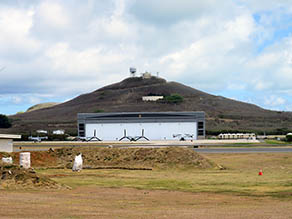
“So the mo‘o Mā‘eli‘eli used to swim out and surf Kū‘au, Pyramid Rock. There’s all kind freshwater out there. To me that means the aquafer connects out there. But they knew which aquifer connected where. We’re talking about the basal groundwater, and the way the weight of the aquifer pushes the water up out there. It’s one of the places we find the Wai a Kāne. "So look in that chant, ‘Aia I hea ka wai a Kāne?’ ["Where is the water of Kāne?"]. If you look at the archaeology for Moku o Loe, they will say there’s no fresh water, we found no sources of fresh water on the island. But I know a geologist who did some drone footage with infrared along that channel, he showed me the pictures. I said ‘What is all this?’ he said ‘Freshwater coming out of the dredged part of the reef.’ Ah ha! Not cut off. So you’re modern change is the thing. A mo‘o got cut off. How do we even know that this is so? Kalani shares the modern story of the Obake (ghost) at Mōkapu “What I’m getting at is this is a repeated, thematic, literary device if you will, the master motif that says that these lateral ridges are the mo‘o, the dragons, they’re the guardians of the freshwater sources.” “He‘eia, what we find over here is land of the mo‘o in Ko‘olau—Ko‘olaupoko and Ko‘olauloa—and the land of the mo‘o is really discussing these lateral ridges that start from the Ko‘olaus and come down. Because the mo‘o, the dragon lizard, is the guardian in the fish ponds; they’re the guardians of the freshwater resources, the estuarian environment. Their body is the lateral ridge. That’s why they embody the fresh water and how it flows: the mo‘o, the flowing just like the snaking of a river down. There’s not only water in the rivers and in streams. There’s water in the lateral ridges that run off the Ko‘olau mountains down to the sea.” “Kualoa is a profile of a gigantic mo‘o,” Kalani adds, pointing beyond He‘eia to the mountains of Kualoa that frame Kāne‘ohe Bay. “And then when you look on that side, you’re at Kualoa in the shadow of the mo‘o, in fact it’s on the maps as Ka Mo‘o Kapu o Hāloa, The Sacred Mo‘o of the god Hāloa. And you look down that side”—Kalani points the opposite direction—“and what do you see at Mōkapu? The outline of a giant turtle. So on one side of the Bay with the turtle guardian, and on this side you've got the giant mo‘o, the dragon guardian. So a special place! “We talk about the story of Hi‘iaka battling the mo‘o up there at Mokoli‘i,” Ian continues. “Why is Mokoli‘i the tail of the mo‘o? Because the mo‘okapu were the lateral ridges that go up to the Ko‘olau Mountains, which are the bodies of the mo‘o, the lizards, which are the water courses running from the aquifer laterally down out to the sea. So, Mokoli‘i is a first-born child of the land, and that’s the tail of the mo‘o.” Ian provides cultural insights about Hi‘iaka and Mokoli‘i “If that is the body of the mo‘o, all the lateral ridge going down, then the theory is that you will find fresh water on Mokoli‘i, the islet, and it’s true because there’s a lithified sandstone cap that runs from Kualoa all the way out to Kahuku. The fresh water flows underneath the capstone. In many stories of sharks and mo‘o swimming, the fish could swim from Mokoli‘i all the way to Kahana and back. “So it’s true. If you go out onto the island, there’s a beach on the makai side, put your feet in the sand—especially after a lot of rain—and you will feel the fresh water coming out the sand. Swim out on to the shallow sea out by Mokoli‘i—plenty people walk to Chinaman’s Hat—and you will see the fresh water coming out from the bottom of the sea. So, a smart Hawaiian could take a gourd, and swim down, turn the gourd upside down, let the fresh water (which is less dense even though it’s colder) float up into the gourd, cap it, swim up slowly, turn it right-side up and have fresh water out of the sea. That’s one smart Hawaiian. “Mo‘o are also related to Kāne worship—Kāne god of freshwater—the ancient Mū and Menehune people who came up here first before anybody, who built all these fish ponds, who settled there in Hakipu‘u and built Mo‘oli‘i fish pond. And the guardian being Mokoli‘i—there’s not as many cases of male mo‘o but he’s one of them. His body is those cliffs right there, you can see his body.” Lilikalā explains mo‘o and the Palikū clan “And that is the importance of the mo‘o-lelo, the mythology,” Ian concludes: “how to find fresh water on an island.”
|
 |
|
 |
Uphill from Mā‘eli‘eli lies the valley of "Rolling Rats." Mahealani discusses the story behind the name ‘Ioleka‘a.
|
 |
||
 |
|
 |
||

|
 |
||||
|
||||
Copyright 2019 Pacific Worlds & Associates • Usage Policy • Webmaster |
||||
